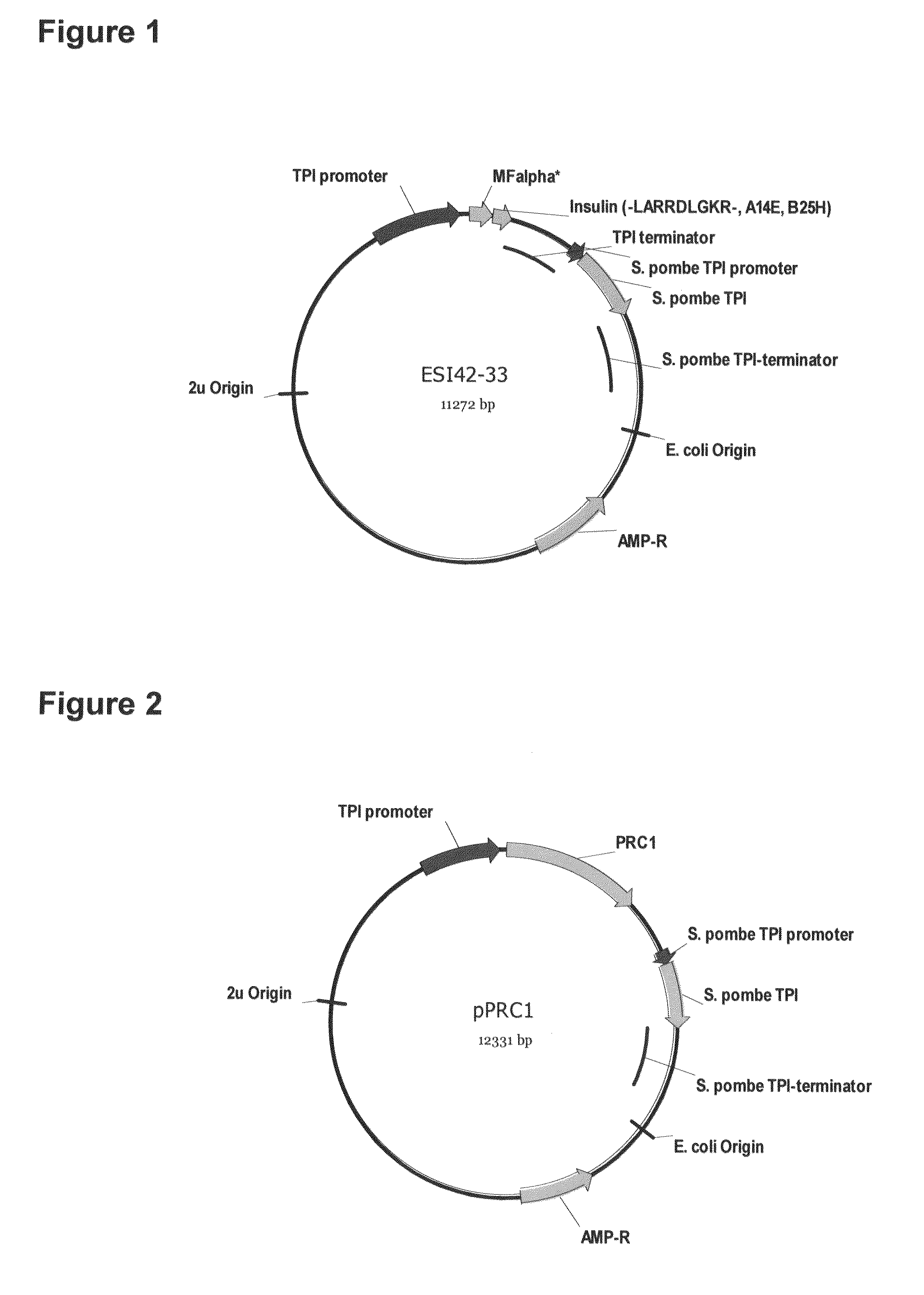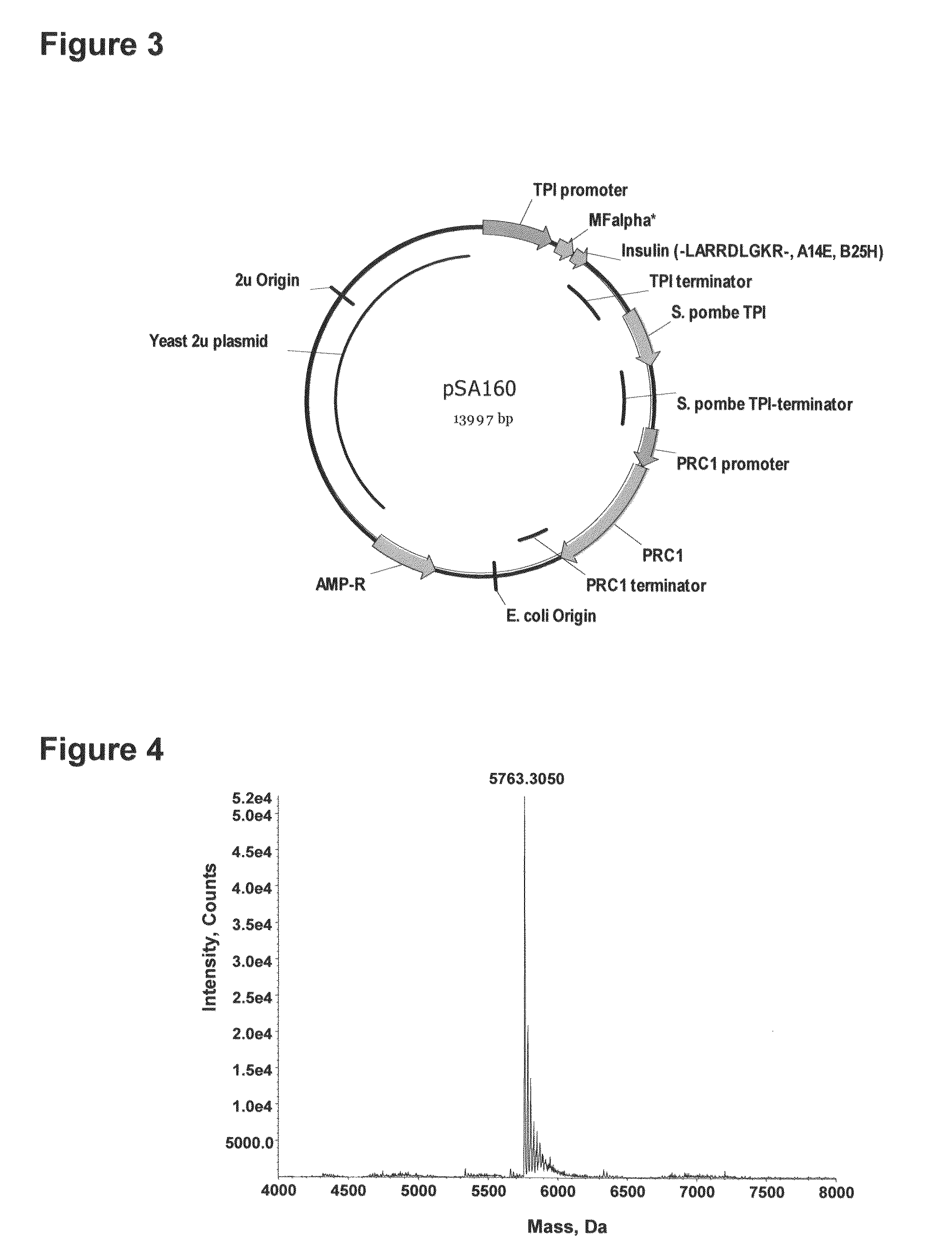Method of making activated carboxypeptidases
a technology of activated carboxypeptides and peptides, which is applied in the direction of fusion with protease sites, animal/human proteins, peptides, etc., can solve the problems of time-consuming enzymatic steps and introduce additional impurities, and achieve the effect of more efficient kex2 cleavag
- Summary
- Abstract
- Description
- Claims
- Application Information
AI Technical Summary
Benefits of technology
Problems solved by technology
Method used
Image
Examples
example 1
[0174]Construction of a yeast expression system for the human insulin precursor B(1-30)-LARRDLGKR(SEQ ID NO:9)-(A1-21), (A14E, B25H) human insulin.
[0175]FIG. 1 shows a yeast plasmid called pESI42-33. The plasmid contains an expression cassette comprising an EcoRI-XbaI fragment inserted into the plasmid between the transcription-promoter and the transcription-terminator of the S. cerevisiae TPI gene. In plasmid pESI42-33 the EcoRI-XbaI fragment encodes a fusion product composed of the MFα1* pre-pro leader, a Lys-Arg cleavage site for the dibasic processing endopeptidase Kex2, and the insulin precursor B(1-30)-LARRDLGKR(SEQ ID NO:9)-(A1-21), (A14E, B25H) human insulin.
[0176]A DNA fragment containing sequences encoding the insulin precursor B(1-30)-LARRDLGKR(SEQ ID NO:9)-(A1-21), (A14E, B25H) human insulin was constructed using synthetic oligonucleotides and standard PCR amplifications. The resulting PCR fragment was purified, digested with NcoI and XbaI and ligated to the NcoI-XbaI ve...
example 2
[0179]Construction of a yeast expression system for the CPY activation mutants.
[0180]FIG. 2 shows a yeast plasmid called pPRC1. The plasmid contains an expression cassette comprising an ClaI-NheI fragment inserted into the plasmid between the transcription-promoter and the transcription-terminator of the S. cerevisiae TPI gene. In plasmid pPRC1 the ClaI-NheI fragment encodes wildtype pre-pro-CPY. All CPY mutant plasmids are identical to pPRC1 except for the relevant point mutations made for introduction of dibasic Kex2 cleavage motifs.
[0181]The DNA fragments containing sequences encoding PRC1 mutated for insertion of Kex2 cleavage sites were constructed using synthetic oligonucleotides, genomic yeast DNA as template and standard PCR amplifications. The resulting PCR fragments were purified, digested with ClaI and NheI and ligated to the ClaI-NheI vector fragment of the modified cPOT type expression vector.
[0182]The expression plasmid was propagated in E. coil, grown in the presence ...
example 3
[0184]Construction of a yeast system for co-expression of the insulin precursor B(1-30)-LARRDLGKR(SEQ ID NO:9)-(A1-21), (A14E, B25H) human insulin and a CPY activation mutants.
[0185]FIG. 3 shows a yeast plasmid called pSA160. The plasmid contains an expression cassette comprising an EcoRI-XbaI fragment inserted into the plasmid between the transcription-promoter and the transcription-terminator of the S. cerevisiae TPI gene. In plasmid pSA160, the EcoRI-XbaI fragment encodes a fusion product composed of the MFα1* pre-pro leader, a Lys-Arg cleavage site for the dibasic processing endopeptidase Kex2, and the insulin precursor B(1-30)-LARRDLGKR(SEQ ID NO:9)-(A1-21), (A14E, B25H) human insulin. The plasmid also contains an expression cassette encoding the CPY mutant “F” comprising a KpnI-SacI fragment inserted into the plasmid between after the transcription-promoter of the S. cerevisiae PRC1 gene.
[0186]The insulin cassette was subcloned into a suitable cPOT type expression vector. Subs...
PUM
| Property | Measurement | Unit |
|---|---|---|
| pH | aaaaa | aaaaa |
| pH | aaaaa | aaaaa |
| concentration | aaaaa | aaaaa |
Abstract
Description
Claims
Application Information
 Login to View More
Login to View More - R&D
- Intellectual Property
- Life Sciences
- Materials
- Tech Scout
- Unparalleled Data Quality
- Higher Quality Content
- 60% Fewer Hallucinations
Browse by: Latest US Patents, China's latest patents, Technical Efficacy Thesaurus, Application Domain, Technology Topic, Popular Technical Reports.
© 2025 PatSnap. All rights reserved.Legal|Privacy policy|Modern Slavery Act Transparency Statement|Sitemap|About US| Contact US: help@patsnap.com



